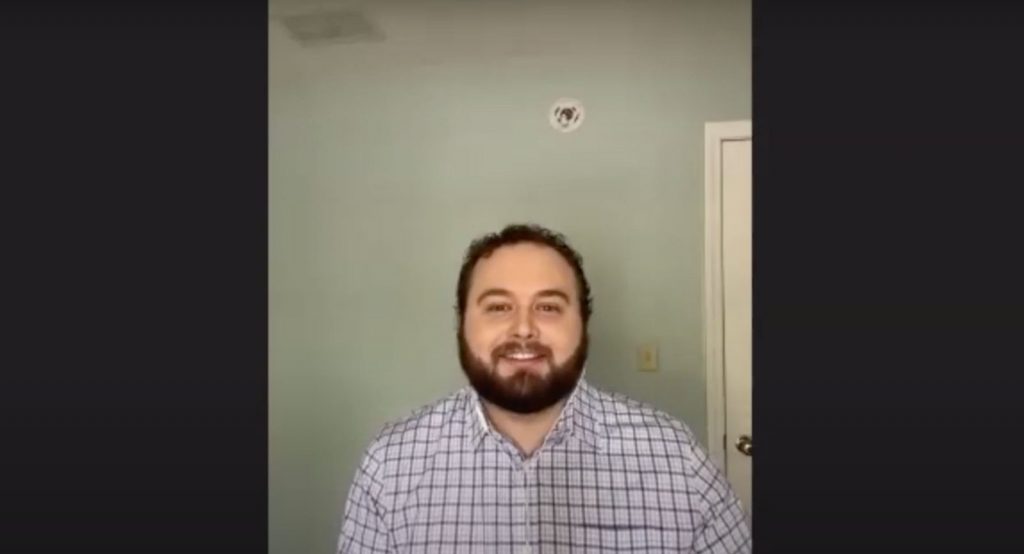Recovering from COVID-19 – Jordan Kinnett’s Story

Vapotherm’s high velocity therapy is a tool for treating respiratory distress. Vapotherm does not practice medicine or provide medical services or advice, any clinical recommendations provided herein are solely those of the speaker. Practitioners should refer to the full indications for use and operating instructions of any products referenced before use.
Jordan Kinnett is the 31 year old registered nurse who authored the now-viral Facebook post about his COVID-19 illness and recovery. He was treated with a Vapotherm Precision Flow® system while in the ICU and was willing to share his story with John Walsh — Vapotherm’s Area Vice President of Clinical — via a video interview.
Jordan’s symptoms started in early March and made him think that he had bronchitis. After persistently getting worse for the next nine days, and ultimately being diagnosed with pneumonia that wasn’t responsive to antibiotics, he was admitted to the emergency department.
“When I was on 5 liters [of low flow oxygen] I was ‘satting’ 88% … And as a clinician, you know, ok, this isn’t good. … I can’t complete a sentence, I have to stop to catch my breath. It was pretty scary. … And I just remember thinking this is how it ends. You know, I’m about to die because I cannot breathe.”
Although he thought he would be intubated, his physicians put him on Vapotherm high velocity therapy to try to keep him off the vent.
“The doctors were kind of up in the air about using Vapotherm because of fear of aerosolization. However … we knew that there’s not enough ventilators to go around, so you gotta have to save those for the people who absolutely need them. And knowing that Vapotherm is a great noninvasive mode of oxygenation, that’s what they went with. … If Vapotherm didn’t happen … I would have been on a ventilator. That’s no question.”
If you’re a healthcare provider with similar concerns, you can read here about ways to protect from nosocomial transmission while using Vapotherm therapy.
For Jordan, even after being placed on the therapy, his work of breathing was hard. He was only able to take “little baby breaths,” but was comforted knowing that the therapy was still giving him enough oxygen even while he was unable to take a deep breath. So long as he was resting, his sats stayed in the 90s.
Being a clinician, he admitted to not being a good patient. He did move around some, which resulted in his FiO2 needing to be titrated up to 100%. But most of the time he was able to stay at 60% oxygen until his condition improved enough that the providers started weaning him after two days in the ICU.
He was anxious to return home quickly. Once he did, he quarantined himself from his spouse and they stayed in separate parts of the house. He continued using a spirometer to test his lungs and reports that it took him two weeks of recovery from the point of discharge to feel like he’s fully back to normal.
The aspect of Jordan’s story that captured so much interest was that he was a 31 year old, otherwise healthy person who had ended up in the ICU from this disease. He says that he has reflux, but that he doesn’t consider it an underlying condition. His story goes against the popular grain that this illness only affects older people or those with underlying conditions and it was one of the key reasons he wanted to share it.
“The local hospital here, they purchased 6 months of equipment and they went through it in a week. They thought they were trying to be ahead of the game because they were expecting one or two patients. … When I was discharged from the hospital, … they had converted med/surg units. The entire floor was now COVID-19 patients. … I feel the people who have underlying health conditions are probably taking this more serious than those who do not. I’ve seen several posts on Facebook from people younger than myself: ‘oh I’m fine, I’m 20 something years old. I don’t have to worry about it.’ Okay, one thing is, you might not, however you’ve got parents and grandparents … how are you gonna feel if you go home, or go visit and then two weeks later your grandmother is on a ventilator?”
Jordan Kinnett thanks the healthcare providers who helped him recover through this ordeal. When we spoke with him, he was getting ready to return to work in a few days. His story has a happy ending and the message he wants to leave us all with is to stay home and take his virus seriously.
“If I had not gone to the hospital, I would have died. … To anybody out there, this is real. Please take it seriously. Stay home. If you have to go to the grocery store, send one person, don’t make it a family venture. … That’s really the best advice I’ve got. It’s just take it seriously.”